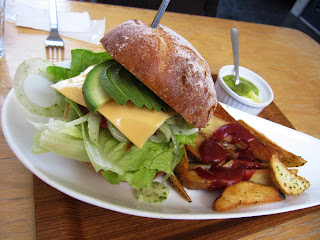There is an area called "Asakusa" in Tokyo, and from 2005, the area started to be reached by the TX line whose terminal station "Tsukuba" is in my city. The area is where you can experience Japanese old settings like the Edo, or Showa period, and old people in Japan visit Asakusa to remember their good old times. And foreign people also often prefer Asakusa over the other areas in Tokyo, just because this area is typically Japanese.
When I got out of the Asakusa station on the TX line, I found this picture. I think this is the dragon that is manipulated by many people at the summer festival. As you can see, it was illuminated by the lighting behind the picture.
There was this picture that shows you the entire map of this Asakusa area. I just thought each street should have English names so that everybody would find out where they should go.
As I was walking down the street, I saw this very old restaurant that was open. In my book, the structure of this restaurant seemed to be that of the early Showa period. You can see a dish called "Tendon" on the right side of the shelf through the window.
When I looked up, I saw this picture that presumably belongs to the genre "Ukiyoe", which depicts the secular aspects of the Edo period.
This street is called "Denpouin Doori", which runs sideways in the center of the map I showed above.
On the "Denpouin Doori", you can see many kinds of shops that sell clothes, bags, shoes and etc. I think all these shops are all run by families, and probably the businesses have been handed down from generation to generation. The price of each commodity was not so expensive, nor very cheap.
This man, who had this old-fashioned hairstyle, was selling "Asakusa yaki", which had sweet bean paste with "Yomogi", or felon herb. He said the peddlers in olden times shouldered the center stick to lift this cubic wooden carrier.
This street is called "Nakamise", on both side of which you can see many shops. I saw many people taking pics.
And one of the shops was selling fans called "Uchiwa". You might want to buy one if you come to this place as a foreigner. I think the average price for these fans was about 5 us dollars. Reasonably priced.
If you walk down the "Nakamise"street to the north, you can reach "Kaminari mon" or Thunder Gate. The original gate dates back to the 10th century, but since then this gate was burned down by fires several times, and finally this was offered by the founder of Panasonic "Kounosuke Matsushita" in 1960. You can see "Raijin" or the god of thunder on your left.
And on your right you can see "Fuujin" or the god of the wind. The two gods often appear as a pair in some old Japanese pictures like this.
This is the big lantern you saw in the center of the gate. You'd see how big it is. The swastika you see denotes a "temple"on the Japanese maps, and it is a symbol of good luck.
---To be continued---





















































